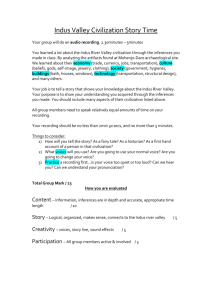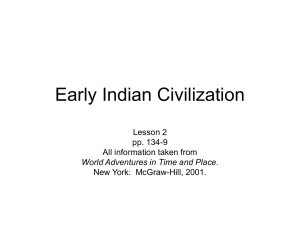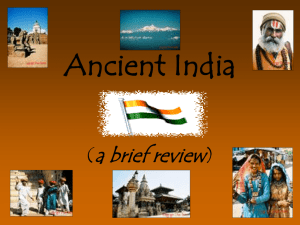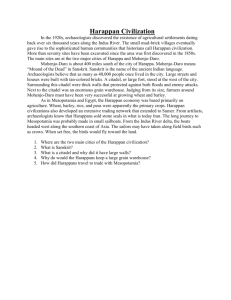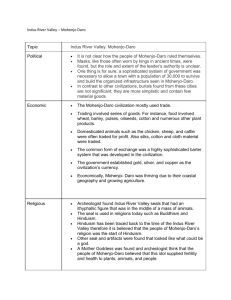Mohenjo-Daro ___/50 - Mr. Butts World History
advertisement
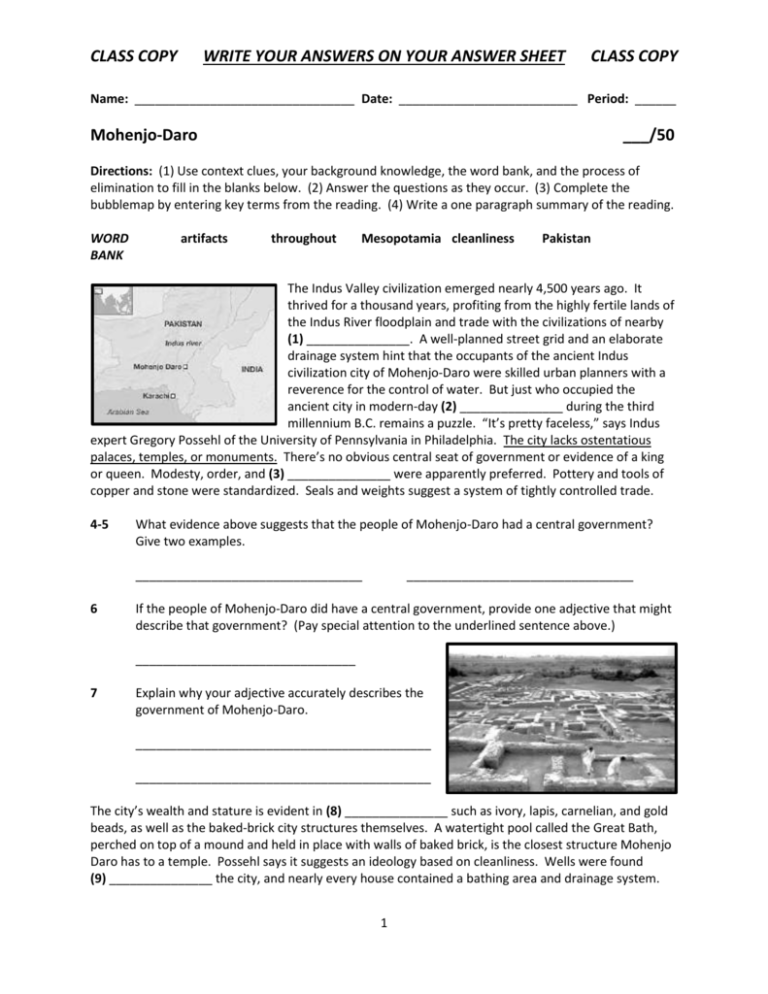
CLASS COPY WRITE YOUR ANSWERS ON YOUR ANSWER SHEET CLASS COPY Name: ________________________________ Date: __________________________ Period: ______ Mohenjo-Daro ___/50 Directions: (1) Use context clues, your background knowledge, the word bank, and the process of elimination to fill in the blanks below. (2) Answer the questions as they occur. (3) Complete the bubblemap by entering key terms from the reading. (4) Write a one paragraph summary of the reading. WORD BANK artifacts throughout Mesopotamia cleanliness Pakistan The Indus Valley civilization emerged nearly 4,500 years ago. It thrived for a thousand years, profiting from the highly fertile lands of the Indus River floodplain and trade with the civilizations of nearby (1) _______________. A well-planned street grid and an elaborate drainage system hint that the occupants of the ancient Indus civilization city of Mohenjo-Daro were skilled urban planners with a reverence for the control of water. But just who occupied the ancient city in modern-day (2) _______________ during the third millennium B.C. remains a puzzle. “It’s pretty faceless,” says Indus expert Gregory Possehl of the University of Pennsylvania in Philadelphia. The city lacks ostentatious palaces, temples, or monuments. There’s no obvious central seat of government or evidence of a king or queen. Modesty, order, and (3) _______________ were apparently preferred. Pottery and tools of copper and stone were standardized. Seals and weights suggest a system of tightly controlled trade. 4-5 What evidence above suggests that the people of Mohenjo-Daro had a central government? Give two examples. _________________________________ 6 _________________________________ If the people of Mohenjo-Daro did have a central government, provide one adjective that might describe that government? (Pay special attention to the underlined sentence above.) ________________________________ 7 Explain why your adjective accurately describes the government of Mohenjo-Daro. ___________________________________________ ___________________________________________ The city’s wealth and stature is evident in (8) _______________ such as ivory, lapis, carnelian, and gold beads, as well as the baked-brick city structures themselves. A watertight pool called the Great Bath, perched on top of a mound and held in place with walls of baked brick, is the closest structure Mohenjo Daro has to a temple. Possehl says it suggests an ideology based on cleanliness. Wells were found (9) _______________ the city, and nearly every house contained a bathing area and drainage system. 1 CLASS COPY WORD BANK WRITE YOUR ANSWERS ON YOUR ANSWER SHEET elevated discovered elected houses Priest acres CLASS COPY Archeologists (10) _______________ first visited Mohenjo-Daro in 1911. Several excavations occurred in the 1920s through 1931. Small probes took place in the 1930s, and subsequent digs occurred in 1950 and 1964. The ancient city sits on (11) _______________ ground in the modern-day Larkana district of Sindh province in Pakistan. During its heyday from about 2500 to 1900 B.C. the city was among the most important to the Indus civilization, Possehl says. It spread out over about 250 (12) _______________ on a series of mounds, and the Great Bath and an associated large building occupied the tallest mound. 13 What evidence from the paragraph above supports that conclusion that the people of MohenjoDaro valued cleanliness? ______________________________________________________________________________ According to University of Wisconsin, Madison, archaeologist Jonathan Mark Kenoyer, the mounds grew over the centuries as people kept building platforms and walls for their (14) _______________. “Gradually you have a high promontory on which people are living,” he says. With no evidence of kings or queens, Mohenjo-Daro was likely governed as a city-state, perhaps by (15) _______________ officials or elites from each of the mounds. 16 Given the context, what might be a synonym that could replace the word “promontory” in the paragraph above? ______________________________ A miniature bronze statuette of a nude female, known as the dancing girl, was celebrated by archaeologists when it was (17) _______________ in 1926, Kenoyer notes. Of greater interest to him, though, are a few stone sculptures of seated male figures, such as the intricately carved and colored (18) _______________ King, so called even though there is no evidence he was a priest or king. The sculptures were all found broken, Kenoyer says. “Whoever came in at the very end of the Indus period clearly didn’t like the people who were representing themselves or their elders,” he says. 19 If Kenoyer is correct about “Whoever came in at the very end of the Indus period,” what does that suggest about the fate of the people of Mohenjo-Daro? ______________________________________________________________________________ 2 CLASS COPY WORD BANK WRITE YOUR ANSWERS ON YOUR ANSWER SHEET abandoned Pakistani nobody CLASS COPY ended Just what (20) _______________ the Indus civilization - and Mohenjo-Daro - is also a mystery. Kenoyer suggests that the Indus River changed course, which would have hampered the local agricultural economy and the city’s importance as a center of trade. But no evidence exists that flooding destroyed the city, and the city wasn’t totally (21) _______________, Kenoyer says. And, Possehl says, a changing river course doesn’t explain the collapse of the entire Indus civilization. Throughout the valley, the culture changed, he says. “It reaches some kind of obvious archaeological fruition about 1900 B.C.,” he said. “What drives that, (22) _______________ knows.” Many walls have already collapsed at the Mohenjo-Daro archeological site. Others are crumbling from the ground up. Preservation work for Mohenjo-Daro was suspended in December of 1996 after funding from the (23) _______________ government and international organizations stopped. In 2012, Pakistani archaeologists warned that, without improved conservation measures, the site could disappear by 2030. 24 The Mohenjo-Daro site has survived for thousands of years. Why might the site be in more danger in modern times than it has been over the past four thousand years? ______________________________________________________________________________ ______________________________________________________________________________ Directions: Complete the bubblemap by entering key terms from the reading in the circles below. Priest King Great Bath MOHENJODARO 3 CLASS COPY WRITE YOUR ANSWERS ON YOUR ANSWER SHEET CLASS COPY Directions: Write a one paragraph summary of the reading. Your paragraph must include four sentences and most of the key terms from the bubblemap above, including the two provided. _____________________________________________________________________________________ _____________________________________________________________________________________ _____________________________________________________________________________________ _____________________________________________________________________________________ _____________________________________________________________________________________ _____________________________________________________________________________________ _____________________________________________________________________________________ Reviewer’s Directions: Review the paragraph above. Score each skill area by circling the appropriate number. Use the notes section to further explain your assessment. Sign your review legibly. PTS IDEAS AND CONTENT 5 fully accomplished task 4+ subject-specific facts PTS ORGANIZATION PTS READABILITY 5 exceptional word usage exceptional writing technique effective tone and voice 5 4 accomplished task at least 3 subject-specific facts 4 4 very good word usage very good writing technique effective tone and voice 3 minimally accomplished task at least 2 subject-specific facts 3 attempted to organize ideas logically 3 2 partially accomplished task at least 1 subject-specific fact 2 minimally attempted to organize ideas logically 2 ordinary word usage attempted to adjust tone and voice to audience 1 failed to accomplish task no subject-specific facts 1 failed to organize or organized illogically 1 less than minimal word usage and writing technique inappropriate tone and voice organized ideas logically organized ideas logically attempted to adjust tone and voice to audience LANGUAGE CONVENTIONS PTS very few or no errors in capitalization, punctuation, spelling, or word usage/very few or no run-on sentences and/or sentence fragments/no errors that impair the flow of communication - errors are infrequent 5 PTS occasional errors in capitalization, punctuation, spelling, grammar, or word usage/may have run-on sentences, sentence fragments/errors do not impede communication; the writer’s message is not seriously obscured 4 PTS frequent errors in capitalization, punctuation, spelling, grammar, or word usage/run-on sentences and/or sentence fragments/errors cause the reader to stop and re-read parts of the writing - errors impair communication 3 PTS many errors in capitalization, punctuation, spelling, grammar, or word usage/run-on sentences and/or sentence fragments/errors are serious and numerous, causing the reader to struggle to discern meaning 2 PTS many errors in capitalization, punctuation, spelling, grammar, or word usage/errors are serious, numerous, and of a wide variety - it is impossible to ascertain what the writer wants to communicate 1 PTS NOTES: _________________________________________________________________________________________________________ ________________________________________________________________________________________________________________ ________________________________________________________ REVIEWER’S NAME: ______________________________________ 4 CLASS COPY WRITE YOUR ANSWERS ON YOUR ANSWER SHEET 5 CLASS COPY



